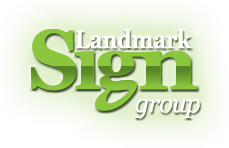9.25.2013
What Makes Great Signage

What Makes Great Signage? The answer depends on whom you talk to you. Michelangelo would probably tell you that the signage is in there and that you just have to get it out of the material. Bill Engvall would probably make fun of you for asking:
“Here’s your sign.”
For most of our clients, the idea of great signage is usually a combination of factors. The end result of those factors would typically be a seamless blend of commerce and beauty.
To help create such efficient signage, Landmark Sign often gathers information from several factors including the elements in the list below.
Knowledge of intended audience / demographic
Like with any basic marketing, to make great signage one needs to know for whom the sign is made. Typically the signage is made to attract customers & general stakeholders. To achieve the desired effect, we need to know who these market segments are. We need to know why the segments would be attracted, what they need and why the sign would benefit them.
Competitor check
We also want to know what the competitors are doing with their signage. Learning more about the competitors, their signage and their assumed success will allow us to better understand the barriers to entry in this space.
Continuity of brand
There are times when restrictions are in place that prevent the client from being too creative. Many clients already have proven brand style guides in place. Sometimes our clients have franchise restrictions & market guidelines that formalize what they are able to do. We talk with our clients to make sure they comply with the regulations while at the same time providing efficient signage that they can be proud of.
Call-to-action message
Once we know a client’s audience, competition and brand continuity, we are able to craft a signage message that provides positive results.
What we look to create is a call-to-action, a message that directs readers to perform a desired action. The desired action is usually to call a phone number, visit a website, send an email or, in some case, let customers know where clients are located so customers can visit. In other cases, it’s simply to provide information.
Signage function (with respect to nearby terrain)
A sign’s function is only as purposeful as its surroundings. Such restrictions are subject to the terrain - the lay of the land. For example...
Line of sight
- an unlit sign is useless in the dark.
- An illuminated LED sign is pointless at night if there’s no way to provide electricity to it.
- a 12-foot tall road sign has limited visibility of it is sandwiched between two other 12-foot-tall road signs.
- a 20-foot-sign will have a limited shelf life if it is sitting over a 17-foot-tree because the trees will grow over it.
Weather & Signage
Materials are also dependent on weather. Indoor signs typically get less sunlight and, therefore, are less subjected to fading. Signs along Lake Michigan will be subjected to much colder weather than signs along the Gulf of Mexico...
Rules & Regulations
Each city, county and state will also have their own rules and regulations at different locations within their jurisdiction which regulate the type of signage allowed in each area.



